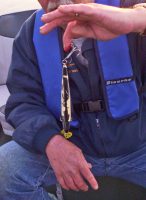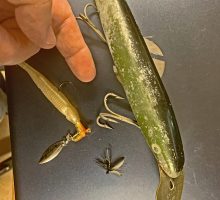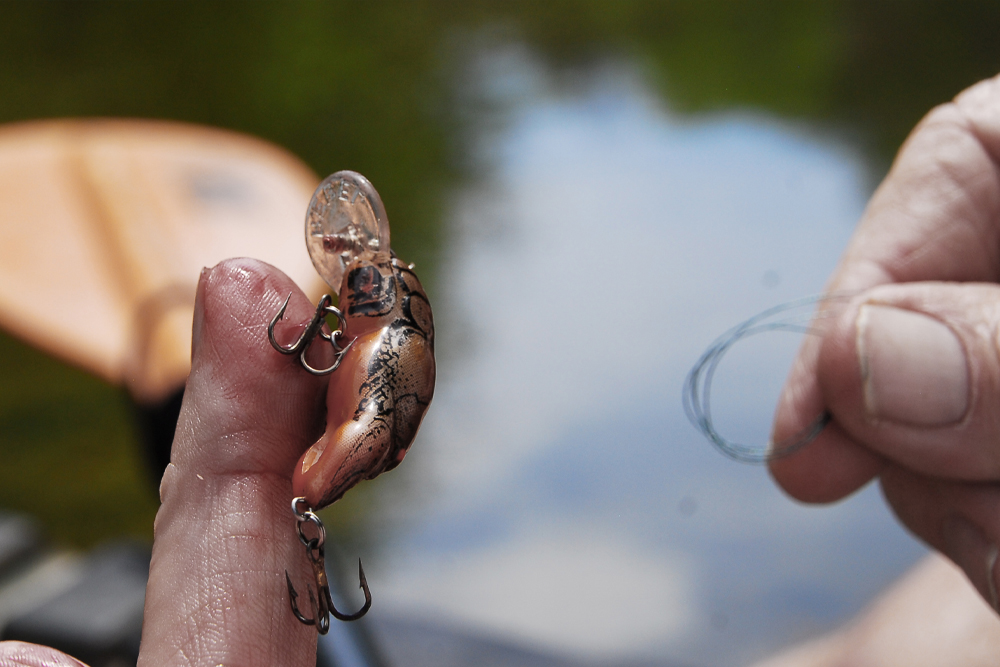It’s every angler’s worst nightmare, hooking yourself, or worse yet, hooking a
friend. But depending upon where you’re hooked, it’s possible the accident
doesn’t have to end your fishing day. (Photo: Richard Hines)
When Fishing Gets You Hooked, Literally!
by Richard Hines
If you’ve fished for any length of time, chances are you know someone who’s been hooked—maybe even you or your fishing partner. Plenty of trips have been cut short or ruined when someone accidentally buries a hook in their skin instead of a fish. No matter what species you’re chasing, accidental hook-ups are always a possibility. Some may be minor—easily handled with a quick tug and a few choice words.
Others can land you in the emergency room.

Listening to a Doctor Who Fishes
Over the years, I’ve spent time on the water with Dr. Bobby Dale. Thankfully, neither of us has hooked the other (yet). But Dr. Dale knows plenty about fishing injuries—he served for years as an emergency room physician in Tupelo, Mississippi. And in Mississippi, people fish. That means Dr. Dale has removed hooks from every conceivable body part in just about every way imaginable.
He told me about one muskie trip where he was the one who got hooked. Fortunately, everyone in the boat was a doctor. The hook ended up in a non-critical spot on his back, so it was a quick and easy fix. But Dr. Dale made a point that stuck with me:
“Where the hook is located, and how deep it’s buried, determines the best way to remove it.”
Two Main Methods of Hook Removal
There are really only two methods for removing a hook when you’re out on the water or onshore.
Cut and Back It Out
This is the most common method for shallow or superficial hooks. First, cut the hook off the lure or line. Then push the point through the skin until the barb pops out. Once visible, either snip the barb off – or if you can’t cut the hook, you can still use pliers to smash the barb down flat against the shank of the hook. Then you can back the hook out the way it came in.
But be warned—Dr. Dale says only use this method if the hook is shallow and not near a tendon, nerve, or joint. If it’s deep or located anywhere sensitive, skip the DIY and head for the emergency room.
The Line Pull Method
This trick can work well if the hook isn’t deeply embedded. Cut the hook free from the lure, then loop a piece of heavy braid or stout fishing line (preferably 40-pound test or stronger) around the bend of the hook. Avoid light line—it can snap or cut your hand.
With the loop in place and the line taut, press down firmly on the eye of the hook with your thumb to disengage the barb. Then, give a quick, confident yank in the opposite direction the hook entered.
This video illustration from Angling Knots illustrates how to do it:

And here’s the pro tip Dr. Dale shared with a laugh: “If you’re doing it for your buddy, count to three—but pull on two. Everyone tenses up on three!”
Know When NOT to Do It Yourself
While it’s good to know these methods, Dr. Dale stressed that hook removal isn’t always a DIY task.
“If the hook is near the eyes, ears, tendons—or if you’re unfamiliar with human anatomy—go to a doctor.”
And no matter who removes the hook, always clean the wound thoroughly and make sure your tetanus shot is up to date.
Richard Hines is a Wildlife Biologist, book author and award winning freelance outdoor writer and photographer. Since 1985, Hines has published hundreds of articles on hunting, fishing, conservation, and natural history.


